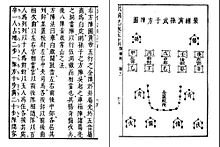Wubei Zhi


Wubei Zhi (Chinese: 武備志; pinyin: Wǔbèi Zhì; Treatise on Armament Technology or Records of Armaments and Military Provisions) is the most comprehensive military book in Chinese history. It was edited by Mao Yuanyi (茅元儀 Máo Yuányí; 1594-1640?), an officer of waterbourne troops in the Ming Dynasty. Wubei Zhi contains 240 volumes, 10405 pages, more than 200,000 Chinese characters, which makes it the longest book in Chinese history regarding military affairs.[1]
Structure
Wubei Zhi consists of five sections, "Bing Jue Ping", "Zhan Lue Kao", "Zhen Lian Zhi", "Jun Zi Sheng", and "Zhan Du Zai".
- "Bing Jue Ping" (Commentary on Military Formulae)
Containing 18 chapters, this section includes military theories such as those of Sun Tzu, some dating back to the last years of Eastern Zhou Dynasty, more than 1,800 years before the editor.
- "Zhan Lue Kao" (Consideration of Tactics)
This section comprises 31 chapters, and describes more than 600 specific examples of battle that took place between the Eastern Zhou Dynasty and the Yuan Dynasty. Among those are Battle of Maling, Battle of Red Cliffs, which is a classic example of defeating overpowering enemy.
- "Zhen Lian Zhi" (Record of Formations and Training)
This section of the book, of 41 chapters, introduces different ways of training troops including infantry, cavalry and chariots, as well as individual martial arts training with different weapons such as the spear and Dao.
- "Jun Zi Sheng" (Summary of Logistics)
This section is divided into 55 categories, covering a variety of contents related to wartime logistics, such as marching, encamping, troops arraying, transmitting orders, attacking and defending cities, and provision of food, weapons, health care and transportation, to name but a few.
- "Zhan Du Zai"
In this section, with 96 chapters, the author introduces aspects of weather and geographic features that are related to war fighting, as well as traditional Chinese methods of divination, formation, and finally marine navigation.
Impact
Being known as "a military encyclopedia in ancient China", Wubei Zhi is one of the most influential works in Chinese history on warfare. The rare source of some compass maps and designs and some weapons has contributed enormously to corresponding areas. Most importantly, this book is a great composition of ancient Chinese military theories. Wubei Zhi is a crystal of ancient Chinese militarists' wisdom.[2]
Bubishi
A second Wubei Zhi, a compendium of topics loosely related to the Fujian-based quanfa traditions of Yongchun White Crane and Monk Fist boxing probably dates from the mid-to-late Qing dynasty (1644–1911). It contains anatomical diagrams, philosophical essays, defensive tactical strategies, and poetry. No author is known; the book is most likely a collection of pieces from various sources put together by an anonymous editor. It was popular in Okinawa among Okinawan-based quanfa practitioners during the 19th and early 20th centuries.
An English translation of this second Wubei Zhi by Koryu Uchinadi instructor Patrick McCarthy was first published in Japan in 1991 and later by Charles E. Tuttle in the United States in 1995 as Bubishi: the Bible of Karate (ISBN 0-8048-2015-5).
See also
References
- ^ Wubei Zhi. (n.d.). Retrieved April 24, 2008, from Baidu Baike. Template:Zh icon
- ^ Wubei Zhi. (n.d.). Retrieved February 24, 2009, from China001.com website. Template:Zh icon
